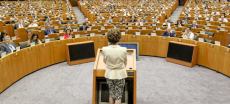
Email: ZYVC057@live.rhul.ac.uk
Total Article : 213
About Me:I'm a graduate student studying International Criminal Law and first started writing for King's News almost 4 years ago! My hobbies include reading, travelling and charity work. I cover many categories but my favourite articles to write are about mysteries of the ancient world, interesting places to visit, the Italian language and animals!

Prussian General Otto Von Bismarck famously once compared policy making to making sausages, the outcome is the most important.
Policy may be defined as a ‘course of action or inaction rather than specific decisions or actions’ (Hugh Heclo) and is a specific set of principles that guide ones decisions and rationale.
If one were to accept this definition then policy is:
Some degree of consistency with a course of action (but not necessarily between them).
A policy has an abstraction (they may be set out in a document but their interpretation rests to a great extent on the individual subjective interpretation, it can be a subjective mental construct).
If policy is a course of action as said above it may have immediately broad or narrow consequences, (e.g. macroeconomic changes entail large-scale consequences).
Policies have aims, which may involve more or less change from the status quo.
Policy making has a temporal and a spatial dimension (in terms of a spatial dimension these decisions and courses of actions bring together a small portion of people which may then influence a broad variety of citizens, by temporal the more time a policy stays the more the state will become reliant on it).
There is a shift from the issue network to the policy community. Rhodes suggests there are lots of different clusters of networks which are found in different issue domains, food, healthcare, defence ect and each has different characteristic features. He establishes a continuum between issue networks and policy communities, which are strongly linked and interdependent. An issue network, found at one end, is formed by a large and open membership holding a large range of interests and opinions, they usually have very little interdependence between them and the government (e.g. fox hunting late 1990s and early 2000s, there were lots of diametrically opinionated groups). At the other end of the continuum there is the policy community with a small and closed membership consisting of few professional participants. They have frequent interaction, usually having resources, large degree of agreement, high levels of interdependency.
Considering the temporal dimension another way of thinking about policy making is in a system. This theory is offered by David Easton, A systems analysis of political life (New York: Wiley, 1965). Political systems, according to this, operate in terms of outputs and inputs. We have society, then within it we have the political system with inputs which take the form of demands (what people want from society) and supports (actions, what society needs us to do, pay taxes for example) and outputs which consist of decisions and policies. It is a sort of feedback mechanism. In the global theatre, policy making has shaped international relations, intra and inter-state diplomacy, wars and peace protocols for centuries. It takes one policy maker to turn a country from bliss to upheaval, from peace to war, from economic prosperity to crises which is why studying the actions of policy makers alongside the process of policy making is crucial to understand the political dynamic we live in today.
Image: http://esharp.eu/files/pictures/debate/68.f2b8554842c7f780a55904ad0aae04ef.jpg

0 Comment:
Be the first one to comment on this article.